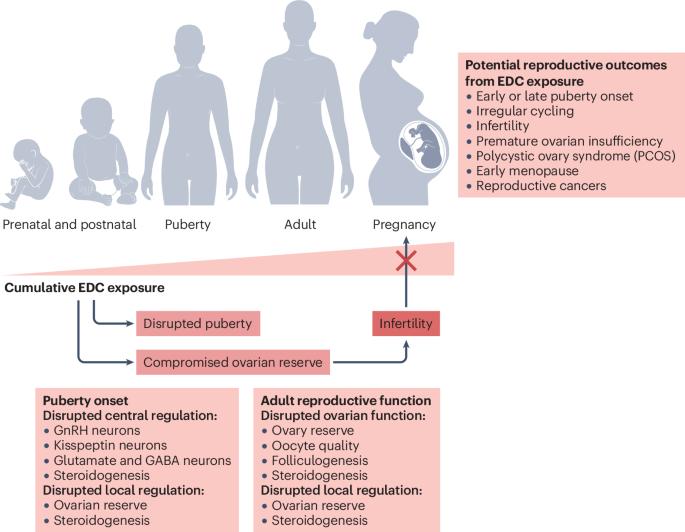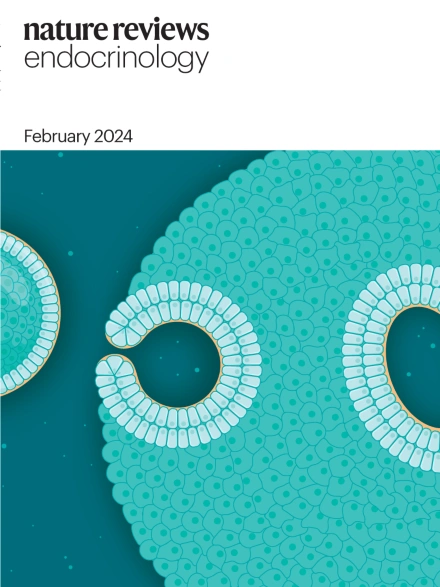干扰内分泌的化学物质与女性生殖健康:日益受到关注。
IF 40
1区 医学
Q1 ENDOCRINOLOGY & METABOLISM
引用次数: 0
摘要
女性的生育能力和生殖健康取决于从胚胎发育到青春期的一系列发育步骤,以及成年后生殖系统的正常功能。卵巢储备的建立和下丘脑-垂体-卵巢轴的发育是两个重要的步骤。在生育年龄,维持足够的卵巢卵泡储备以及平衡的生殖器官神经内分泌控制对生育至关重要。在发育或成年期间,这些事件中的任何一个失调都可能导致生殖障碍。在过去的50年里,人类生育率下降了,而女性生殖障碍的发病率上升了,这种趋势部分与环境因素有关,如接触内分泌干扰化学物质(EDCs)。在这里,我们概述了EDCs如何影响卵巢储备在早期发育、成年期的维持以及建立下丘脑-垂体对青春期和排卵的控制的流行病学和机制证据。我们的综述不仅有力地支持了EDC暴露在女性生殖疾病(如青春期异常、生育能力受损、过早绝经或多囊卵巢综合征)发展中的作用,但也强调了知识空白,包括难以证明暴露与人类疾病表现之间的因果关系。本文章由计算机程序翻译,如有差异,请以英文原文为准。

Endocrine-disrupting chemicals and female reproductive health: a growing concern
Female fertility and reproductive health depend on a series of developmental steps from embryogenesis through puberty, in addition to the proper functioning of the reproductive system in adulthood. Two important steps are the establishment of the ovarian reserve and development of the hypothalamic–pituitary–ovarian axis. During reproductive years, maintaining an adequate ovarian reserve of follicles as well as balanced neuroendocrine control of reproductive organs is crucial for fertility. Dysregulation of either of these events, during development or in adulthood, can lead to reproductive disorders. Over the past five decades, human fertility rates have declined, whereas the incidence of female reproductive disorders has risen, trends partially linked to environmental factors such as exposure to endocrine-disrupting chemicals (EDCs). Here we outline epidemiological and mechanistic evidence for how EDCs affect the ovarian reserve during early development, its maintenance during adulthood and the establishment of the hypothalamic–pituitary control of puberty and ovulation. Our Review not only reveals strong support for the role of EDC exposure in the development of female reproductive disorders such as abnormal puberty, impaired fertility, premature menopause or polycystic ovarian syndrome, but also highlights knowledge gaps, including the difficulty to prove causality between exposure and human disease manifestation. This article outlines evidence pointing to an important contribution of endocrine-disrupting chemicals to increasing rates of female reproductive disorders such as abnormal puberty, impaired fertility, premature menopause or polycystic ovarian syndrome reported over the past half a century.
求助全文
通过发布文献求助,成功后即可免费获取论文全文。
去求助
来源期刊

Nature Reviews Endocrinology
医学-内分泌学与代谢
CiteScore
42.00
自引率
0.70%
发文量
158
审稿时长
6-12 weeks
期刊介绍:
Nature Reviews Endocrinology aspires to be the foremost platform for reviews and commentaries catering to the scientific communities it serves. The journal aims to publish articles characterized by authority, accessibility, and clarity, enhanced with easily understandable figures, tables, and other visual aids. The goal is to offer an unparalleled service to authors, referees, and readers, striving to maximize the usefulness and impact of each article. Nature Reviews Endocrinology publishes Research Highlights, Comments, News & Views, Reviews, Consensus Statements, and Perspectives relevant to researchers and clinicians in the fields of endocrinology and metabolism. Its broad scope ensures that the work it publishes reaches the widest possible audience.
 求助内容:
求助内容: 应助结果提醒方式:
应助结果提醒方式:


